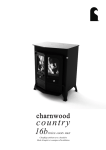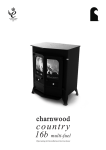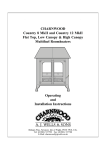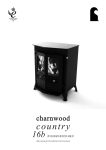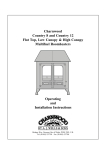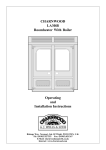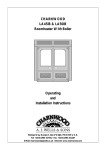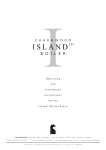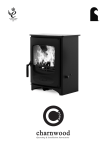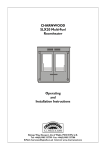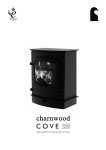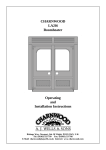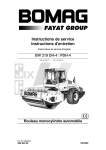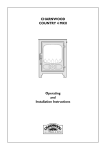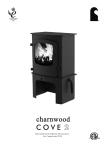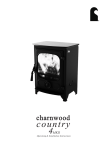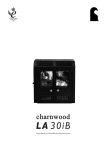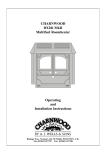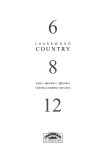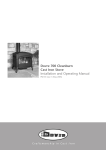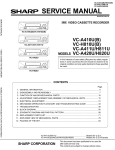Download Charnwood Roomheater Operating instructions
Transcript
CHARNWOOD COUNTRY 15B Roomheater with Boiler Operating and Installation Instructions OPERATING INSTRUCTIONS FOR THE CHARNWOOD COUNTRY 15B Before lighting the stove check with the installer that the work and checks described in the Installation Instructions have been carried out correctly and that the chimney has been swept, is sound and free from any obstructions. Do not light the fire before the boiler and heating system have been filled with water as this can damage the boiler. FUELS reduced outputs. The wood should be cut and split and then left to season in a well ventilated dry place for at least one year but preferably two years before use. Peat Ensure that the peat is well dried before use. Burning wet peat will give rise to heavy tar deposits and reduced outputs. PETROLEUM COKE IS NOT SUITABLE FOR USE ON THIS APPLIANCE. ITS USE WILL INVALIDATE THE GUARANTEE. Please pay careful attention to the special points made with each type of fuel as they will help you to get the best from your stove. It must be remembered that only smokeless fuels may be burnt in smoke control areas on this stove. If you are not sure whether you are in a smoke control area, then please check with your Local Authority. At first you may find it helpful to try several fuels to find the most suitable. If you are unable to obtain the fuel you want ask your supplier, or an approved fuel distributor to suggest an alternative. Smokeless Fuels DOOR OPERATION The recommended smokeless fuels which are suitable for use in smoke control areas on this stove are as follows: Ancit, (Phurnacite Plus) Anthracite Large Nuts, Homefire, Maxibrite, Phurnacite, Sunbrite Doubles, Welsh Dry Steam Coal (Large Nuts). Coal 1) In the solid fuel position the grate bars are vertical with gaps in between allowing the primary combustion air to come up through the grate and through the fuel bed. 2) In the wood position the grate bars are horizontal, allowing the combustion air to come round the sides of the grate and over the top of it. When in the wood position ash is able to build up on the grate as is necessary for effective wood or peat burning. Use the door opening and ashpan tool to open and close the doors. Turn the right-hand door knob anti-clockwise to open and clockwise to close (see Fig.1) Movement of the grate from one position to the other is effected using the tool supplied as shown in Fig.2. The grate is put into the solid fuel position by moving the tool up until the handle is in the 1 o'clock position. The grate is put into the wood position by moving the tool down until the handle is in the 5 o'clock position. To riddle the appliance when burning solid fuels the tool should be moved between the 1 o'clock and 3 o'clock positions several times. When burning wood or peat the ash should be allowed to build up and riddling should only be carried out once or twice a week. MULTIFUEL GRATE LIGHTING Your Charnwood stove is fitted with a multifuel grate which enables both solid fuels and wood to be burned equally effectively. The grate has two positions:- The stove may be lit using dry kindling wood and paper or fire lighters. Set the grate into either the wood position or the solid fuel position as required. Place the paper, Housecoal doubles, trebles or cobbles may all be burnt. Do not use singles, small nuts, or coal dust Airwash Control It is important that large size coal is used (ie. larger than 2 inch or 50 mm in size). The coal should be dry. Closed Open Door handle When burning coal a little extra care is needed. Please take note of the section "Special Points For Burning Coal". To Open Thermostat Wood Only dry well seasoned wood should be burnt on this appliance as burning wet unseasoned wood will give rise to heavy tar deposits in the stove, on the glass and within the chimney. For the same reason hard wood is better than soft wood. Burning wet unseasoned wood will also result in considerably Control Thermostat Flap (Behind Panel) Fig.1 Stove Controls Page 1 Country 15B 09/03 Riddler Lever or fire lighters, and kindling on the grate and cover with approximately 2 inches of fuel. Turn the control knob to maximum, and open the airwash control fully (see Fig. 1). Light the paper or fire lighters. Close the doors until the fuel is well ignited then load with fuel and adjust the air controls to the required setting. On initial lighting, the stove may smoke and give off an odour as the silicon paint with which the firebox is painted reacts to the heat. This is normal and will cease after a short time, but meanwhile the room should be kept well ventilated. When relighting the stove, riddle (if burning solid fuel), remove any clinker from the firebed and then empty the ashpan. CONTROLLING THE FIRE The rate of burning and hence the output is controlled by the control knob on the side of the fire and the airwash control (see Fig.1). REFUELLING Keep the firebox well filled but do not overfill to prevent fuel from spilling over the top of the front fire bars. Care should be taken especially when burning wood that fuel does not project over the front fire bars or damage to the glass may be caused when the doors are closed, it can also cause the glass to black up. ASH CLEARANCE The ashpans should be emptied regularly before it becomes too full. Never allow the ash to accumulate in the ashpans so that it comes in contact with the underside of the grate as this will seriously damage the grate bars. The ashpans are handled using the tool provided. Care should be taken to ensure that ash is cool before emptying it into plastic liners or bins. To make ash removal easier there is a special Charnwood ash carrier available. This may be purchased from your supplier or, in case of difficulty, from ourselves. The control knob is linked to a thermostat which senses the boiler temperature. The number at the front of the knob is the number at which it is set. The airwash control should be kept at least slightly open most of the time to keep the glass clean. It may be fully opened when rapid heating is required or to help clean any deposits from the glass. It will not be possible to keep the glass clean if this control is fully closed, particularly immediately after refuelling. After a period of slumbering always turn the air control up to maximum and wait until flames appear above the fuel bed before opening the doors. Burning coal will produce more soot deposits than other fuels, especially if the fire is run at low levels for long periods. It is therefore vital to clean the throat plate regularly, weekly cleaning is recommended. Never fully close the Airwash control when burning coal. SPECIAL POINTS WHEN BURNING WOOD AND PEAT The grate should be kept in the wood burning position and should not be riddled until the ash becomes so deep that it begins to block the passage of air into the firebox at the side of the grate. When this is the case do not remove all of the ash using the riddling mechanism but keep a layer about half an inch thick as this enables the wood to burn more effectively. When burning wood or peat use the airwash control in the same way as described (see "CONTROLLING THE FIRE" ) OVERNIGHT BURNING For overnight burning the fire doors must be closed. Solid Fuel RIDDLING When burning solid fuels riddling twice a day is usually sufficient. When burning wood or peat, ash should be allowed to build up and generally weekly riddling will be sufficient. The fire should be riddled with the doors shut (see Fig 2.) Place the tool onto the riddling lever and rotate between the 1 o'clock and 3 o'clock positions several times. Too much riddling can result in emptying unburnt fuel into the ashpan and should therefore be avoided. If any clinker forms it should be removed from the firebed. After riddling, the grate should be put back into the solid fuel or wood position as required (the tool should be in the 1 o'clock position for solid fuel or in the 5 o'clock position for wood). each stage for the flames to appear above the fire. Riddle Wood Fig 2. Grate Operation SPECIAL POINTS WHEN BURNING COAL When loading the stove take care not to smother the fire, instead fill the firebox in two stages waiting between Page 2 Country 15B 09/03 When burning solid fuel the ashpans should be emptied and the fire riddled. If the fire is very low then it may be necessary to add a little fuel and turn the thermostat control up to maximum for a brief period until the fire is burning brightly before filling with fuel. When the new fuel has ignited, the thermostat control should be turned down to the required setting and the airwash control moved to a low setting. If the central heating pump is off overnight then the thermostat may be left at the same setting for both day and night operation. If the central heating pump is on overnight then set the thermostat control to give the required level of heating. Some experimentation will be necessary to find the settings most suitable for the particular fuel used and the draw on the chimney. To revive the fire, empty the ashpans, riddle, and open the air controls to e) that an extractor fan is not fitted in the same room as the stove. f) there is sufficient draw in the chimney, (once the chimney is warm a draught reading of at least 0.10 inches water gauge should be obtained). maximum. When the fire is burning well load on more fuel as necessary and move the air controls to the desired setting. When burning wood use large logs rather than small ones. Proceed as above, but do not riddle the fire either when shutting down or reviving. Throat Plate Door Glass Blacks Up CLEANINGAND MAINTENANCE The stove is finished with a high temperature paint which will withstand the temperatures encountered in normal use. This may be cleaned with a damp lint-free cloth when the stove is cold. Should repainting become necessary, high temperature paints are available from your supplier or from stove shops. The glass in the doors is a zero expansion ceramic glass, capable of withstanding the heat of the fire. Before cleaning the glass open the doors and allow them to cool. Clean the glass using a damp cloth and then wiping over with a dry cloth. Any stubborn deposits on the glass may be removed with a proprietary stove glass cleaner or ceramic hob cleaner. Some deposits on the glass may be burnt off simply by running the fire at a fast rate for a few minutes. Do not use abrasive cleaners or pads as theses can scratch the surface which will weaken the glass and cause premature failure. THROAT PLATE AND FLUEWAY CLEANING It is important that the throat plate and all the stove flueways are kept clean. When burning smokeless fuels they should be cleaned monthly. When burning other fuels they should be cleaned at least once a week, and more frequently if necessary. It is not necessary to let the fire out completely to carry out these operations. The throat plate is lowered using the door opening tool. Slide the tool into the bracket from the side, pull the throat plate forward, and then lower it as shown in Fig. 3. Any sooty deposits should then be swept from the plate and into the fire. While the throat plate is lowered clean any sooty deposits from the boiler faces and the airwash tubes. Return the throat plate to its correct position - raise the front of the plate, push it back and then lower it onto the retaining lugs. Tool Pull Forward and Swing Down Fig.3 Throat Plate Location CHIMNEY SWEEPING The chimney should be swept at least twice a year. Where a top outlet is used it will generally be possible to sweep the chimney through the appliance. First remove the side fire plates, front firebars and the throat plate. Then sweep the chimney ensuring that soot is removed from all horizontal surfaces after sweeping. In situations where it is not possible to sweep through the appliance the installer will have provided alternative means, such as a soot door. After sweeping the chimney the appliance flue outlet and the flue pipe connecting the stove to the chimney must be cleaned with a flue brush. After clearing any soot from within the stove, replace the throat plate (see Fig. 3), the front firebars, and side fireplates. Different types of sweep's brushes are available to suit different flueways. For standard brick chimneys a wire centre sweep's brush fitted with a guide wheel is recommended. For prefabricated insulated chimneys the manufacturers instructions with regard to sweeping should be consulted. Keeping the glass clean requires a certain amount of experimentation due to the differences in the draw of different chimneys. The following points should be noted and with a little care should enable the glass to be kept clean in most situations: a) The airwash relies on a supply of heated air to keep the glass clean, therefore, when lighting the stove allow the firebed to become well established before closing the air controls. This may also be necessary when re-fuelling the stove. b) When re-fuelling keep the fuel as far back from the front firebars as possible, do not try to fit too much fuel into the firebox. c) Never completely close the airwash control - as a guide it should be at least a quarter open. d) Wet wood or logs overhanging the front firebars will cause the glass to blacken. It is always more difficult to keep the glass clean when running the stove very slowly for long periods. If blackening of the glass still occurs check that all flue connections and the blanking plate are well sealed. It is also important that the chimney draw is sufficient, (when the chimney is warm a draught reading of at least 2.54 mm, or 0.10 inches, water gauge should be obtained), and that it is not affected by down-draught. When burning coal some blackening of the glass may occur below the level of the front firebars. This will not obscure the view of the fire or affect its performance. Fume Emission. TROUBLE SHOOTING Fire Will Not Burn. Check that: a) the air inlet is not obstructed in any way, b) chimneys and flueways are clear, c) that a suitable fuel is being used, d) that there is an adequate air supply into the room, Page 3 Country 15B 09/03 Warning Note: Properly installed and operated this appliance will not emit fumes. Occasional fume from de-ashing and re-fuelling may occur. Persistent fume emission is potentially dangerous and must not be tolerated. If fume emission does persist, then the following immediate actions should be taken: a) Open doors and windows to ventilate the room. b) Let the fire out and safely dispose of the fuel from the appliance. c) Check for flue or chimney blockage, and clean if required. d) Do not attempt to re-light the fire until cause of fume has been identified, if necessary seek professional advice. The most common cause of fume emission is flueway or chimney blockage. For your own safety these must be kept clean. Over-Firing If the fire is over-fired it will cause premature failure of the internal fire parts. Overfiring is occurring when any parts of the fire begin to glow red. To prevent over-firing ensure that: a) the door seals are kept in good condition, and that the doors are sealing correctly, b) the thermostat on the fire is working correctly, c) a suitable fuel is being used, d) the fire is not fitted onto a heating system which is too large. Fire blazing out of control Check that : a) The doors are tightly closed. b) The aircontrols are set at the minimum setting. c) the thermostat flap is closed (at the bottom of the left hand side of the appliance, see Fig. 1.) and that it is not prevented from closing completely by a piece of ash, d) The airwash control is closed. e) A suitable fuel is being used. f) Door seals and airwash slide are intact. Freezing Do not light the fire if there is any possibility that any parts of the system may be frozen. Lack of Heat To Radiators / Hot Water Check that: a) the fire is burning properly - if not then carry out the checks under "Fire Will Not Burn". b) the throat plate is fitted correctly (see Fig. 3.) and that it is not distorted. c) the door seals are in good condition. Page 4 Country 15B 09/03 d) If the hot water goes cold when the pump is turned on, or if some radiators are hotter than others, then the system may need balancing, the pump may be pumping the water too quickly around the system, or the radiators may need bleeding. Please ask your installer to check these points. Chimney Fires. If the chimney is thoroughly and regularly swept, chimney fires should not occur. However, if a chimney fire does occur turn the controls to the minimum setting, and tightly close the doors of the appliance. This should cause the chimney fire to go out in which case the controls should be kept at the minimum setting until the stove has gone out. The chimney and flueways should then be cleaned. If the chimney fire does not go out when the above action is taken then the fire brigade should be called immediately. After a chimney fire the chimney should be carefully examined for any damage. Expert advice should be sought if necessary. INSTALLATION INSTRUCTIONS FOR THE CHARNWOOD COUNTRY 15B HEALTH AND SAFETY PRECAUTIONS Please take care when installing the stove that the requirements of the Health and Safety at Work Act 1974 are met. Some types of fire cement are caustic and should not be allowed to come into contact with the skin. In case of contact wash with plenty of water. If there is a possibility of disturbing any asbestos in the course of installation then please use appropriate protective equipment. CHIMNEY In order for the appliance to perform satisfactorily the chimney height must not be less than 4 metres measured vertically from the outlet of the stove to the top of the chimney. The internal dimensions of the chimney should preferably be 175 mm (7 inches) or 200mm (8 inches) either square or round and MUST NOT BE LESS THAN 150 mm (6 INCHES). (kW) There must not be an extractor fan fitted in the same room as the stove as this can cause the appliance to emit fumes into the room. There must be an adequate air supply into the room in which the appliance is installed totalling at least 100 square cm. (16 square inches) to provide combustion air. This is particularly necessary if the room is double glazed. Do not light the fire before the boiler has been connected to the system and filled with water, as this can cause serious damage to the boiler. In addition to these instructions the requirements of BS.8303 and BS.6461 Pt 1&2; 1984 must be fulfilled. Local Authority Bylaws and Building Regulations regarding the installation of Solid Fuel burning appliances, flues and chimneys must also be observed. PERFORMANCE The output of the Country 15B is 13.0 kW (44,400 Btu/h) to water and 2.5 kW (8,500 Btu/h) to the room. The outputs were obtained burning smokeless fuel over a four hourly refuelling cycle with the doors closed. The heat output to the room is directly proportional to the heat output to water as shown in Fig. 4. This means that if the water heating load is less than the rated output then the room heating will be reduced by the same proportion. This must be borne in mind when calculating the heating requirements. It is important that there is sufficient draw in the chimney and that the chimney does not suffer from downdraught. When the chimney is warm the draw should be not less than 2.54 mm (0.10 inches) water gauge. If in doubt about the chimney seek expert advice. HEARTH AND FIRE SURROUND Boiler Output If it is found that there is excessive draw in the chimney then a draught stabilizer should be fitted. 14.0 12.0 10.0 8.0 6.0 4.0 2.0 0 0 1.0 2.0 Space Output 3.0 (kW) Fig. 4. Performance Chart If an existing chimney is to be used it must be swept and checked, it must be in good condition, free from cracks and blockages, and should not have an excessive cross sectional area (e.g. greater than 250mm x 250mm). If you find that the chimney is in poor condition then expert advice should be sought regarding the necessity of having the chimney lined. If it is found necessary to line the chimney then a lining suitable for Solid Fuel must be used. If there is no existing chimney then a prefabricated block chimney or a twin walled insulated stainless steel flue to BS.4543 can be used either internally or externally. These chimneys must be fitted in accordance with the manufacturers instructions and Building Regulations. Single wall flue pipe is suitable for connecting the stove to the chimney but is not suitable for using for the complete chimney. Page 5 Country 15B 09/03 The stove must stand on a fireproof hearth and must be situated at least 300mm (12 inches) from any combustible material. The positioning of the stove and the size of the hearth are governed by building regulations for Class 1 appliances. These building regulations state that the hearth must extend in front of the stove by at least 300mm (12 inches) and to the sides of the stove by at least 150mm (6 inches). If in doubt as to the positioning of the stove expert advice should be sought either from the supplier or the local building inspector. The fireplace must allow good circulation of air around the appliance to ensure that maximum heat is transferred to the room and also to prevent the fireplace from overheating. A gap of 150mm (6 inches) each side and 300mm (12 inches) above the appliance should give sufficient air circulation. If a wooden mantelpiece or beam is used in the fireplace it should be a minimum of 460mm (18 inches), and preferably 600mm (24 inches) from the appliance. In some situations it may be necessary to shield the beam or mantelpiece to protect it. CENTRAL HEATING SYSTEM The central heating system must comply with BS:5449 part 1. If the system is to be a combined heating and domestic hot water system then a double feed indirect hot water storage cylinder to BS:1556 part 1 should be used. In order to prevent the build up of scale and corrosion a suitable inhibitor should be used. The system must be correctly vented as shown in Figs. 5 and 6. The height differential between the header tank and the appliance must not exceed 15.2 metres (50 feet). If all four boiler tappings are used then, if possible, diagonal pairs should be connected for domestic hot water and central heating. Where a common return is used an injector tee must be incorporated into the system as shown in Fig. 7. This will ensure that a good domestic hot water supply is maintained when the central heating pump is operating. The system must incorporate a gravity circuit which will normally heat the domestic hot water and an unvalved radiator with an output of at least 1 kW. When the appliance is not connected to a domestic hot water system the unvalved radiator(s) on the gravity circuit must have an output of at least 1.25 kW. This is to prevent boiling in case of pump failure. All pipework in the primary circuit must be 28 mm diameter and the gravity flow pipe must rise continuously from the boiler to the open vent. Two typical systems are shown in Figures 5. and 6. If the appliance is used to heat a small central heating system then the heat output to the room from the fire will be reduced. Fig. 4. shows the ratio of space heating to water heating which can be expected. Fitting a radiator in the same room as the fire is recommended as it will allow greater flexibility in the way that the system is operated as well as ensuring that there is sufficient heat. Connect the heating system to the boiler ensuring that the primary flow pipe rises continuously from the appliance to the vent. Fill the system with water and check for leaks. 22mm Open Vents Feed and Expansion Tank Cold Water Tank Overflow Overflow Domestic Hot Water Draw Off Gravity Radiator Drain Cock Indirect Hot Water Cylinder Central Heating Flow Minimum Return Thermostat Circulating Pump Central Heating Return Drain Cock at Lowest Point Fig. 5. Typical Central Heating & Hot Water System Using 4 Boiler Tappings 22mm Open Vents Feed and Expansion Tank Cold Water Tank Overflow Overflow Domestic Hot Water Draw Off Gravity Radiator Drain Cock Indirect Hot Water Cylinder Minimum Return Thermostat Central Heating Flow Circulating Pump Central Heating Return Drain Cock at Lowest Point Injector Tee SYSTEM CONTROLS The circulating pump may be controlled by means of time switches, room thermostats or outdoor thermostats. Radiators may be either manually or thermostatically controlled. These controls will all work in conjunction with the thermostat on the appliance and the low limit pipe thermostat. Fig. 6. Typical Central Heating & Hot Water System Using 3 Tappings Gravity Return (28mm Pipe) Central Heating Return We recommend fitting a pipe thermostat onto the gravity return to act as a low limit thermostat This should be wired into the mains supply Common Return to Boiler (28mm Pipe) Fig. 7. Injector Tee. Page 6 Country 15B 09/03 Blanking Plate Soot Door In Side or Rear Alternative Of Chimney Soot Door Back of the Stove Positions Register Plate With Soot Door Blanking Plate Clamping Plate with fold horizontal Clamping plate finishes flush with inside face of firebox top and bottom. Fig 8. Vertical Register Plate With Bricked Up Fireplace Fig 11. Horizontal Register Plate With Vertical Rear Flue Connector Alternative Soot Door Positions Register Plate With Soot Door domestic hot water. These thermostats are available from ourselves if you are unable to obtain them locally. CONNECTIONS TO FLUES There are several ways of connecting the stove to the flue. These are illustrated in figures 8 to 10. Fig 9. Horizontal Register Plate With Rear Flue Connection Alternative Soot Door Positions Register Plate With Soot Door If the optional vertical rear flue connector is used then the chimney may be swept through the appliance. Horizontal lengths of flue must be kept to a minimum and should not be more than 150mm (6 inches) long. The sealing face of the flue collar must be coated with fire cement before fixing to the body of the stove using the two screws provided. The blanking plate must be removed, sealed with fire cement and refitted, care being taken to ensure that the fold on the clamping plate is in line with the lugs on the firebox as shown in Fig. 12. Ensure the clamping plate does not prevent the throat plate from seating correctly. All flue connections must be well sealed. Ensure that the canopy is securely bolted to the body of the stove. Fig 10. Horizontal Register Plate With Top Flue Connection SOOT DOORS to the pump so that if the gravity return temperature drops below 45º C then the pump will cut out. This will help to prevent condensation forming on the boiler faces and will thereby increase the life of the boiler. It will also ensure that priority is given to the It is possible to pass a 16 inch diameter sweeps brush through the appliance but in most back outlet installations it will be necessary to have a soot door to enable the chimney to be swept. This may either be in the actual brickwork of the chimney or in the register plate. Page 7 Country 15B 09/03 Seal Blanking Plate with fire cement Fig. 12. Flue Blanking Plate. Various types and positions of soot doors are shown in figures 8 to 10. THERMOSTAT Before lighting the fire check the cold setting distance of the thermostat. Remove the cover plate on the left hand side of the stove to give access to the thermostat. With the control knob at the maximum setting the flap should be 18 mm from the air inlet as shown in Fig. 13. To adjust the distance slacken the locking nut and adjust as necessary. When set correctly re-tighten the locking nut. Ensure that the flap opens and closes freely as the 18mm Locking Nut Thermostat Flap Fig. 13. Thermostat Setting knob is turned. PRE LIGHTING CHECK roof of the appliance and should be checked to ensure that it has not become dislodged in transit. The method of location and positioning of the throat plate is shown in Fig. 3. Before initial lighting the following points should be checked :- COMMISSIONING 2. The plates round the sides and back of the grate must be in position and sitting correctly. On completion of the installation and after allowing a suitable period of time for the fire cement and mortar to dry out, the stove should be lit and checked to ensure that smoke and fumes are taken from the appliance up the chimney and emitted safely. Also check all joints and seals. 3. The throat plate must be fitted in the The central heating pump should be 1. The bottom grate bars must all be fitted and should move freely and easily when the riddling mechanism is operated. Flue outlet may be top or rear 655 136 45 882 adjusted to give the correct water flow against the circuit resistance and the system should be correctly balanced. On completion of the installation and commissioning please leave the operating instructions with the customer and advise on the use of the appliance and any controls on the system. Boiler tappings are 1" BSP Female 487 Ø154 815 937 857 340 616 389 Country 15B Dimensions (All dimensions are in mm) Page 8 Country 15B 09/03 334 Issue D CHARNWOOD COUNTRY 15B PARTS LIST 38 40 35 48 Items 26 & 27 are not used on models after serial no. 1926 Item 24 has been replaced by items 51 & 52 but they are not interchangeable. 9 23 39 28 14 52 7 13 6 10 11 46 12 33 15 21 43 41 45 44 47 42 16 32 34 29 15 21 30 31 17 31 19 Item Part No. Description 1* 008/FV35L Left Hand Door Seal 2* 008/FV35R Right Hand Door Seal 3* 008/FV35/S Door Seal Set Incl. Adhesive 4* 008/FW29 Door Seal Adhesive 5* 008/TW44S Glass Channel (set of 8) 6 006/LW30 Glass (Inc Channel) 7 004/EW23 Glazing Bar 8 002/FV07 Front Firebars 9 010/FV31 Throat Plate 10 012/FV14/1 Secondary Air Slide 11 012/FV14/2 Secondary Air Slide Guide 12 012/FV14/3 Secondary Air Slide Retainer 13 012/FV14/4 Secondary Air Cover 14 004/FV15 Secondary Air Rod 15 002/EW15 Side Fire Plate 16 002/BV16 Back Fire Plate 17 002/CG01 Bottom Grate Bar 18 002/CG01S14 Set of Grate Bars (14 per set) 19 004/FV17L Left Hand Ashpan 20 004/FV17R Right Hand Ashpan 21 004/BV19 Ash Shedding Plates 22 008/BW39/S Hinge Pin Set (4 per set) 23 008/FW27 Hinge Post 24 008/FV03/A Door Catch Assembly 25 002/BV12 Left Hand Door Knob 26 012/TW14 Primary Air Slide 27 004/FV18 Primary Air Slide Guide 28 002/TW13 Air Control Knob 29 012/BV20/A Ashpan / Door Opening Tool 30 012/BV22/A Riddling Tool 31 002/BV30 Carrier Bar 32 012/BV33 Mover Bar 33 012/BV23 Riddler Rod 34 012/CG05 Idler Rod 35 010/FV06 Low Canopy * These items are not shown on the drawing. CHARNWOOD 20 8 27 26 28 7 Item Part No. 36 002/FV01 37 002/FV02 38 002/CH12B 39 009/CO15B/A 40 012/TW09 41 002/TW34 42 008/FW48 43 008/FV49 44 008/BW50 45 012/FV10B/19 46 012/FV11 47 012/FW34 48 010/TW33 49* 010/BW51 50* 008/TH02/L 51 002/DY18 52 002/KV14 6 23 22 36 25 24 37 51 24 Description Left Hand Door Right Hand Door Flue Collar Firebox / Boiler Assy (Country 15B) Blanking Plate Riddler Knob & Lever Thermostat Thermostat Flap Thermostat Knob Thermostat Cover Serial No. Label Scraper Tool Vert. Rear Flue Connector (Opt'l Extra) Ash Carrier (Optional Extra) Low Level Pipe Stat (Opt'l Extra) R.H. Door Knob & Spindle Door Catch Cam To obtain spare parts please contact your local stockist giving Model, Part No. and Description. In case of difficulty contact the manufacturer at the address shown. This drawing is for identification purposes only Bishops Way, Newport, Isle of Wight PO30 5WS, United Kingdom T:+44 (0)1983 537799 F:+44 (0)1983 537788 [email protected] www.charnwood.com Your Local Charnwood Dealer











